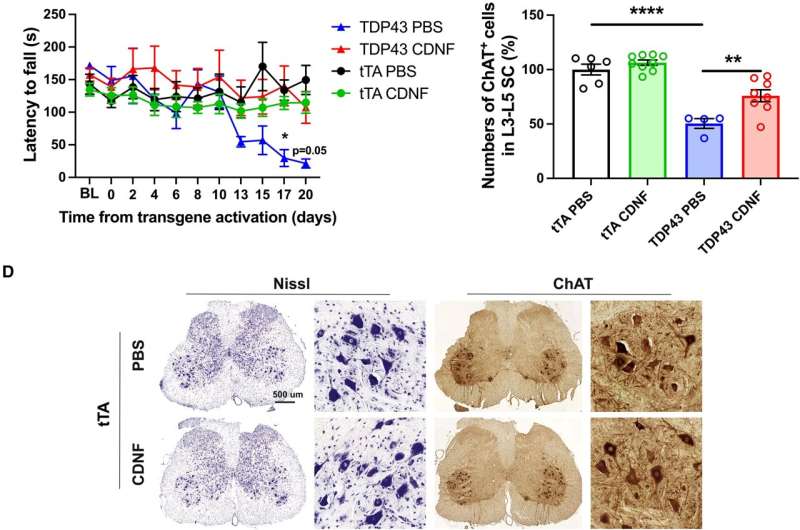This article has been reviewed according to Science X's editorial process and policies. Editors have highlighted the following attributes while ensuring the content's credibility:
fact-checked
peer-reviewed publication
trusted source
proofread
A promising drug candidate for ALS prolongs lifespan and eases symptoms in rats and mice

A research group at the University of Helsinki and its partners have found a promising drug candidate for the treatment of amyotrophic lateral sclerosis (ALS). Cerebral dopamine neurotrophic factor CDNF prolongs the lifespan of and alleviates disease symptoms in rats and mice in animal studies.
Amyotrophic lateral sclerosis (ALS) is a rapidly progressing fatal neurodegenerative disease that affects the nerve cells in the brain and spinal cord. Specifically, a selective degeneration of motoneurons occurs in the spinal cord, leading to muscle atrophy and paralysis. Most patients with ALS die from respiratory failure, usually within one to three years from symptom onset. There is no cure for ALS, and the only drug available in Europe, riluzole, only prolongs ALS patient survival by a couple of months.
Assistant professor Merja Voutilainen and researchers from the Regenerative Neuroscience Group, Faculty of Pharmacy and Institute of Biotechnology, University of Helsinki, together with their national and international collaborators, investigated the therapeutic effect of a protein called cerebral dopamine neurotrophic factor (CDNF) in several cellular and animal models of ALS.
The CDNF protein, discovered by Professor Mart Saarma laboratory in 2007, is mostly found in the endoplasmic reticulum (ER) within cells. ER is an important cell organelle mainly involved in the synthesis and maturation of circa one-third of all proteins in the cell. CDNF has previously shown therapeutic potential in Parkinson's disease.
In the new study published in Brain, the Regenerative Neuroscience Group used three animal models that were genetically modified to express human mutations (TDP43-M337V and SOD1-G93A) affecting ALS patients. Their goal was to investigate whether CDNF can affect disease development in the rodent models of ALS and elucidate its mechanism of action.
They were particularly interested in studying ER stress, which is a cellular response to protecting cells and its proteins. If ER stress becomes chronic, as is the case in many neurological diseases, it can cause cell death.
"We found that administration of CDNF to ALS mice and rats significantly improves their motor behavior and halts the progression of paralysis symptoms. Symptom amelioration is reflected in an increased number of surviving motoneurons in the spinal cord of the animals compared to rodents that did not receive CDNF. Our experiments suggest that CDNF may rescue motoneurons by reducing the ER stress response and, therefore, cell death. Importantly, ER stress was present in all our animal models, independently of the specific genetic mutations" says Dr. Francesca De Lorenzo, lead author of the study.
Professor Michael Sendtner from the University of Würzburg, Germany, one of the world's leading researchers in the field of ALS research and co-author of the study, comments, "This study opens the way to a rational therapy to counteract one of the most severe cellular pathologies in ALS: ER stress."
"CDNF holds great promise for the design of new rational treatments for ALS," says Dr. Merja Voutilainen, Assistant professor at the University of Helsinki and the director and senior author of the study.
More information: Francesca De Lorenzo et al, CDNF rescues motor neurons in models of amyotrophic lateral sclerosis by targeting endoplasmic reticulum stress, Brain (2023). DOI: 10.1093/brain/awad087





















